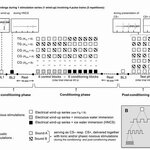Neuroscience

When something captures your interest, like this article, unique electrical rhythms called gamma oscillations sweep through your brain.
These gamma oscillations reflect a symphony of cells—both excitatory and inhibitory—playing together in an orchestrated way. Though their role has been debated, gamma waves have been associated with higher-level brain function, and disturbances in the patterns have been tied to schizophrenia, Alzheimer's disease, autism, epilepsy and other disorders.
Now, new research from the Salk Institute shows that little known supportive cells in the brain known as…

People can be conditioned to feel less pain when they hear a neutral sound, new research from the University of Luxembourg has found. This lends weight to the idea that we can learn to use mind-over-matter to beat pain.
Scientists have known for many years that on-going pain in one part of the body is reduced when a new pain is inflicted to another part of the body. This pain blocking is a physiological reaction by the nervous system to help the body deal with a potentially more relevant novel threat.
To explore this “pain inhibits pain” phenomenon, painful electric pulses were first…

Researchers have identified the functions of two classes of pheromone receptors, and found pheromones crucial to triggering the mating process in mice.
They found one class of receptors helps a male mouse detect pheromones that indicate when a female is present. The other class of receptors lets him know if the female mouse is ovulating and ready to mate. Pheromones, chemical signals that stimulate social responses in others of the same species, trigger many of these inborn behaviors. These chemical signals can let an animal know when a suitable mate is near and activate the release of…

Fragile X syndrome (FXS) is a genetic disorder that causes obsessive-compulsive and repetitive behaviors, and other behaviors on the autistic spectrum, as well as cognitive deficits. It is the most common inherited cause of mental impairment and linked to autism.
Researchers have published a study that sheds light on the cause of autistic behaviors in FXS. The study describes how MMP-9, an enzyme, plays a critical role in the development of autistic behaviors and synapse irregularities, with potential implications for other autistic spectrum disorders.
MMP-9 is produced by brain cells.…

Astrocytes, the cells
that make the background of the brain and support neurons, might be behind mental
disorders such as depression and schizophrenia, according to new research by a
Portuguese team from the ICVS at the University of Minho. The study, in this month Molecular Psychiatry, shows how a simple reduction of astrocytes in
the prefrontal cortex (which is linked to cognition) can kill its neurons and
lead to the cognitive deficits that characterise several mental diseases. Although
malfunctioning astrocytes have been found in psychiatric patients before, it was unclear if…

Researchers have helped identify over 100 locations in the human genome associated with the risk of developing schizophrenia, in what is the largest genomic study published on any psychiatric disorder to date. The findings point to biological mechanisms and pathways that may underlie schizophrenia, and could lead to new approaches to treating the disorder, which hasn't made much scientific progress in the last 60 years.
Schizophrenia, a debilitating mental illness that affects approximately one out of every 100 people worldwide, is characterized by hallucinations, delusions, and…

"She'll grow out of it," used to be a common phrase about raising kids, meaning it wasn't anything that was wrong physically or in upbringing, it is just the diversity of human existence. Some kids develop later. But in today's hyper-diagnosis culture, researchers have wanted to figure out if that old saying was true, or just wishful thinking.
A study of 473 sets of twins followed since birth has found that, compared to single-born children, 47 percent of 24-month-old identical twins had language delay compared to 31 percent of non-identical twins. Overall, twins had twice the rate of…

A new paper in Nature Genetics finds that nearly 60 percent of the risk of developing autism is genetic and most of that risk is caused by inherited variant genes that are common in the population and present in individuals without the disorder.
Although autism is thought to be caused by an interplay of genetic and other factors, there has been no consensus on their relative contributions and the nature of its genetic architecture. Recently, evidence has been mounting that genomes of people with autism are prone to harboring de novo mutations - rare, spontaneous mutations that exert…

In the last few months, pop star Selena Gomez and actress Kristen Johnston have said they struggle with lupus, bringing new attention to the autoimmune disease.
They join a list of celebrities such as R&B singer Toni Braxton, Nick Cannon, host of “America’s Got Talent” and Seal, who has a form of the disease that caused the infamous scars on his face. Even Lady Gaga claimed she tested “borderline positive” for lupus.
But while people may be familiar with who has it, many do not know what it actually is.
Selena Gomez. Credit: North Shore LIJ
Here are 10 facts you should know about the…

A new image-based strategy helps identify and measure placebo effects in randomized clinical trials for brain disorders.
A team of researchers at the Feinstein Institute's Center for Neurosciences, led by David Eidelberg, MD, has developed a method to identify brain patterns that are abnormal or indicate disease using imaging techniques.
To date, this approach has been used successfully to identify specific networks in the brain that indicate a patient has or is at risk for Parkinson's disease and other neurodegenerative disorders.
Parkinson's disease is the second most common…